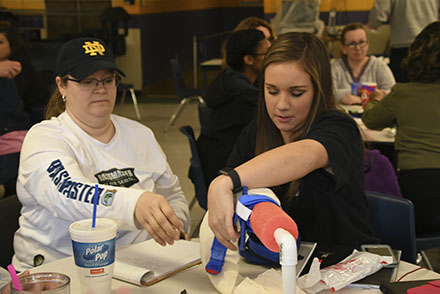School system employees get hands- on training in ‘Stop the Bleed’ session
Published 4:58 pm Tuesday, March 13, 2018

- BHS teacher Erica Farmer and BHS Guidance Counselor Jennifer Voyles put their skills to the test after learning three types of ways to stop a bleeding emergency.
Monday afternoon Decatur County Fire and Rescue led a Stop the Bleed training seminar for Decatur County Board of Education employees at Bainbridge Middle School.
According to the Department of Homeland Security, the White House launched Stop the Bleed in 2015. The intention was to launch a national awareness campaign and call to action. They wanted to encourage bystanders to become trained, equipped and empowered to help in a bleeding emergency before professional help arrives. Stop the Bleed provides kits for staff members, supplied with necessities in the event of a bleeding emergency.
Officer Jamie Earp was the leader of the seminar and said he realized teachers and other employees have a lot on their plate, but knowing this information could help save a life. He explained to the teachers that uncontrollable bleeding in a trauma is the leading cause of death; it doesn’t necessarily have to be in a classroom, but it can be a wreck or other serious situation when they would need these skills to stop the bleeding.
First and foremost, Earp said to call 911 if they are able. However, bystanders always need to be aware of their surroundings and move themselves to safety as well. Officers don’t ever want it to be a them or me situation.
Once the bystander has assessed their safety, they are asked to apply pressure with their hands on the wound. They need to expose where the bleeding is coming from and apply firm, steady pressure to the bleeding site with both hands if possible.
If clean cloths are available, continue to apply firm, steady pressure and stuff the bleeding site with bandages and clothing. Earp explained to the staff that clean does not have to mean sterile; it can be a shirt, washcloth or anything ready and available.
If the bleeding persists, teachers can take a tourniquet out of their kit and place it two- three inches above the bleeder. The tourniquet can be applied and secured over clothing. Earp stressed to the teachers the tourniquet will not be comfortable. If the injured is complaining of discomfort, they probably placed it correctly. The tourniquet should be so tight, a paramedic would not be able to get three fingers under the band.
Officers showed the staff how to pull the tourniquet strap through the buckle, twist the rod tightly and clip and secure the rod with the clasp and time Velcro strap. They explained in some instances one tourniquet isn’t enough, so teachers may have to result to two. In that scenario, teachers simply place the second tourniquet three inches above the first.
After the instructional video, teachers were allowed to practice on pool noodles attached to PVC pipe. Officers walked around to assist and explain if there was a better way to stop the bleed.
Teachers were dismissed after the practice, but intend to keep practicing with their kits in the event of a bleeding emergency.





